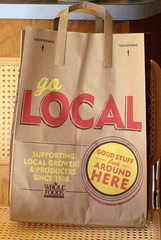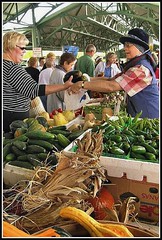Think globally, eat locally? Maybe, maybe not . . .

Posted June 27, 2008 at 1:48PM
I’m not sure I quite understand the fervent passion of what seems to be a full-fledged movement to get consumers to buy and eat local, but I can think of some very good reasons to do just that.  For instance, maybe you want to support local businesses of all kinds, including farms (I do). Or maybe you want to keep farming competitive to help save the local countryside from sprawl (I do, again). Or maybe you like the sense of community that comes with patronizing a community farmers’ market or co-op (my favorite reason), or like the nutritional value of eating the freshest produce.
For instance, maybe you want to support local businesses of all kinds, including farms (I do). Or maybe you want to keep farming competitive to help save the local countryside from sprawl (I do, again). Or maybe you like the sense of community that comes with patronizing a community farmers’ market or co-op (my favorite reason), or like the nutritional value of eating the freshest produce.
Count me in. But I don’t necessarily buy that becoming a “locavore” is inherently better for the environment. The emissions-reduction argument in favor is well-stated on the web site Sustainable Table:
“A tremendous amount of fossil fuel is used to transport foods such long distances. Combustion of these fuels releases carbon dioxide, sulfur dioxide, particulate matter and other pollutants into the atmosphere, contributing to global climate change, acid rain, smog and air pollution. Even the refrigeration required to keep your fruits, vegetables, dairy products and meats from spoiling burns up energy.”
But the real answer may be sometimes yes, sometimes no. As Roberta Kwok writes in Salon,
“But what if conventional distributors make up for the long journeys by driving big trucks packed with produce? Let's say a distributor travels 1,000 miles and carries 1,000 apples to market, while 10 local farmers each drive a pickup 100 miles and carry 100 apples each. The local farmers log fewer food miles but cover the same total distance -- and use a comparable amount of fossil fuels -- for the same amount of food.”
 Kwok did some back-of-the-envelope analysis on five categories of produce on sale in supermarkets and farmers’ markets in California. She found that locally grown squash was indeed more carbon-efficient in its transportation. But, for apples,
Kwok did some back-of-the-envelope analysis on five categories of produce on sale in supermarkets and farmers’ markets in California. She found that locally grown squash was indeed more carbon-efficient in its transportation. But, for apples,
“While the two local apple farmers traveled one-tenth the distance, their loads averaged less than 700 pounds -- and generated six times more carbon dioxide per pound of apples than the semi-trailer trucks.”
The plot thickens. Kwok cites a bunch of reasons why the calculations aren’t at all simple, especially when you dig into such issues as intermediary distributors, the per-pound fuel efficiency of trucks typically driven by farmers and those driven by supermarket wholesalers, and the miles driven by consumers to the store or market. A number of studies from the Leopold Center for Sustainable Agriculture and researchers in the United Kingdom and New Zealand suggest, though, that in many instances the big supermarkets probably beat the local farmers on limiting carbon emissions.
Michael Specter, writing in the New Yorker, makes many of the same points:
“Last year, a study of the carbon cost of the global wine trade found that it is actually more “green” for New Yorkers to drink wine from Bordeaux, which is shipped by sea, than wine from California, sent by truck. That is largely because shipping wine is mostly shipping glass. The study found that ‘the efficiencies of shipping drive a ‘green line’ all the way to Columbus, Ohio, the point where a wine from Bordeaux and Napa has the same carbon intensity.’
“The environmental burden imposed by importing apples from New Zealand to Northern Europe or New York can be lower than if the apples were raised fifty miles away. ‘In New Zealand, they have more sunshine than in the U.K., which helps productivity,’ [researcher Adrian] Williams explained. That means the yield of New Zealand apples far exceeds the yield of those grown in northern climates, so the energy required for farmers to grow the crop is correspondingly lower . . .
“Williams and his colleagues recently completed a study that examined the environmental costs of buying roses shipped to England from Holland and of those exported (and sent by air) from Kenya. In each case, the team made a complete life-cycle analysis of twelve thousand rose stems for sale in February . . . the carbon footprint of the roses from Holland—which are almost always grown in a heated greenhouse—was six times the footprint of those shipped from Kenya. Even Williams was surprised by the magnitude of the difference. ‘Everyone always wants to make ethical choices about the food they eat and the things they buy,’ he told me. ‘And they should. It’s just that what seems obvious often is not. And we need to make sure people understand that before they make decisions on how they ought to live.’”
I recommend both articles, as well as the analysis and links on the Sustainable Table site, which collectively are rich with information if not consistency. As I said, there are lots of reasons other than the carbon consequences of “food miles” to buy and eat local. But we cannot say unequivocally that carbon emissions reduction is always among them. Another glass of Bordeaux, please.